The Micron M510DC SSDs are built for optimization during read-heavy workloads including content delivery and virtualization, fitting alongside (and not replacing) the existing M500DC line. This new line of light enterprise drives are based off of proven technology designed to hit low price points rather than delivering blistering performance. As such, the M510DC SSDs fit a very important demographic in organizations who have a multi-tier flash approach or can characterize their read-centric workloads and leverage this type of flash appropriately. Micron also ensures the M510DC has a complete set of enterprise features with its third-generation power loss architecture to protect data both at rest and in flight and its focus on reliability and longevity.
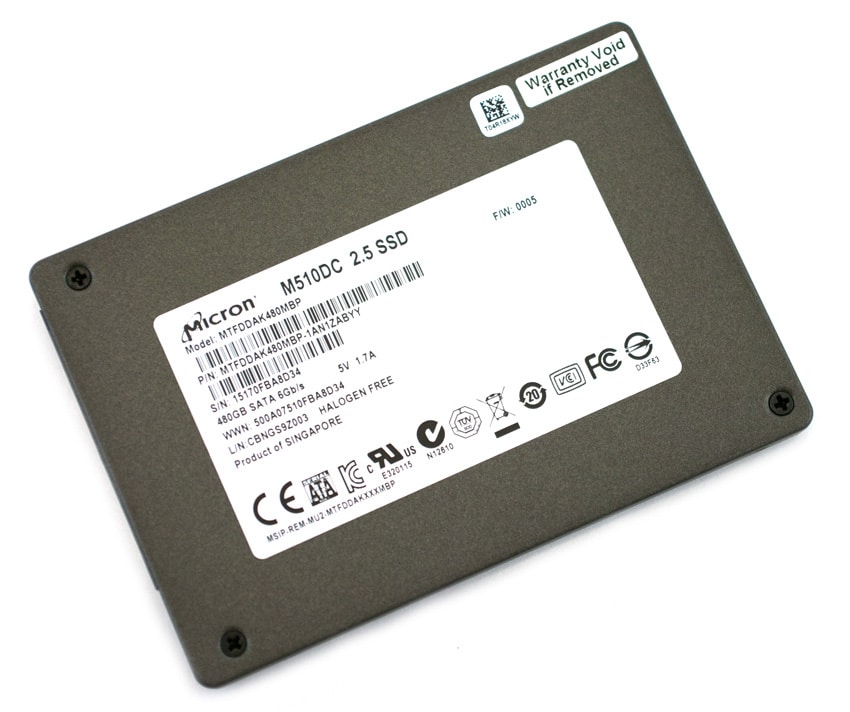
Micron has designed their new SSDs with XPERT (eXtended Performance and Enhanced Reliability Technology), a suite of Micron-designed storage architecture enhancements that help to improve SSD performance and reliability. Included with XPERT is the DataSAFE feature, which provides data path protection by storing metadata and user data to help ensure that the M510DC returns the exact data requested. In addition, Micron’s RAIN (Redundant Array of Independent NAND) technology provides data protection that improves on traditional ECC implementations by calculating and storing additional protection that is parity. For those who worry that it may impact drive performance, Micron’s SSD controllers have built-in data acceleration engines that streamline RAIN.
As far as the specifics of its performance are concerned, Micron quotes the M510DC with 420MB/s for sequential reads and up to 380MB/s in sequential writes. Its random read and write throughout is clocked at a maximum of 65,000 IOPS and 23,000 IOPS, respectively. As we mentioned above, the M510DC’s focus is certainly not performance heavy, as it is specifically designed for those who put more importance on reliability and cost profile for read-centric workloads over raw power.
The Micron M5100DC line of SSDs are available in capacities of 120GB, 240GB, 480GB, and 960GB and come with a 5-year warranty.
Micron M5100DC Specifications:
- Performance (Steady State):
- Sequential Read @ 128KB: 420MB/s
- Sequential Write @ 128KB:
- 170MB/s (120GB)
- 290MB/s (240GB)
- 380MB/s (480GB)
- 380MB/s (960GB)
- Random Read @ 4KB:
- 63,000 IOPS (120GB, 240GB, 480GB)
- 65,000 IOPS (960GB)
- Random Write @ 4KB:
- 12,000 IOPS (120GB)
- 18,000 IOPS (240GB)
- 23,000 IOPS (480GB)
- 10,500 IOPS (960GB)
- Endurance – DWPD (up to):
- 2 (120GB, 240GB, 480GB)
- 1 (960GB)
- MTBF 2M Hours: @M Hours
- Power
- Idle/Standby/Sleep: 1.2W
- Active Average: 1.5W
- Active Maximum:
- 4.0W (120GB)
- 5.0W (240GB)
- 6.0W (480GB)
- 6.3W (960GB)
- Extended Features: RAIN, Advanced R/W Management, Power Loss Protection – Data at Rest + Data in Flight , Enterprise Data Path Protection
Design and build
The style and chassis of the Micron M510DC Enterprise SSD is virtually identical to that of its older M500DC brother. It is comprised of a simple grey, all-metal enclosure with an information label and branding on the front of the drive. This basic, no frills design is common for enterprise SSDs, as its primary is performance and functionality.
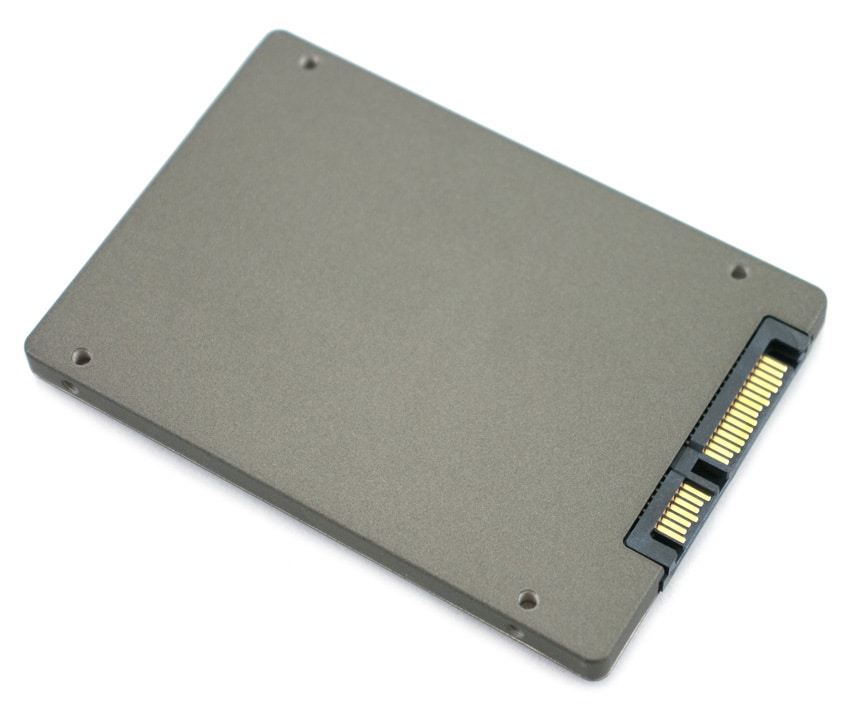
Turning the drive to the side shows four screw holes (2 on each side) for easy mounting for the Micron M510DC. To open up the drive, simply remove the four phillips screws and pry the cover open.
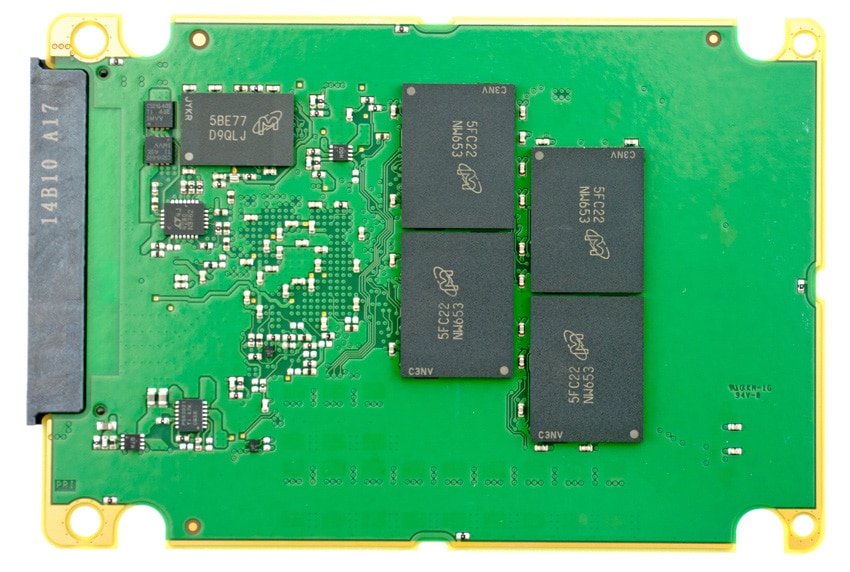
When looking under the hood, you will see Micron’s 16nm MLC as well as the company’s DDR3 DRAM and NAND. Additionally, its onboard capacitors retain power for the drive if any unexpected power loss occurs, all the while committing any pending WRITE commands to persistent memory.
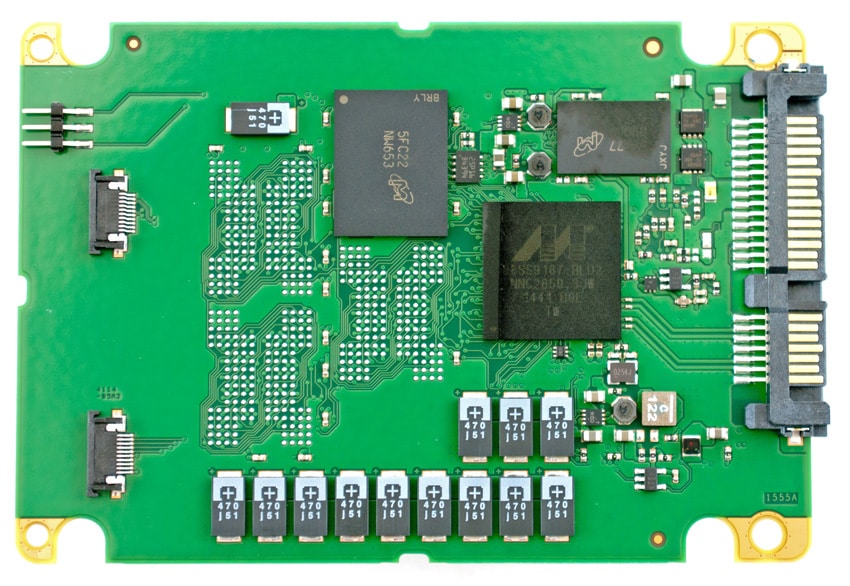
Testing Background and Comparables
The StorageReview Enterprise Test Lab provides a flexible architecture for conducting benchmarks of enterprise storage devices in an environment comparable to what administrators encounter in real deployments. The Enterprise Test Lab incorporates a variety of servers, networking, power conditioning, and other network infrastructure that allows our staff to establish real-world conditions to accurately gauge performance during our reviews.
We incorporate these details about the lab environment and protocols into reviews so that IT professionals and those responsible for storage acquisition can understand the conditions under which we have achieved the following results. None of our reviews are paid for or overseen by the manufacturer of equipment we are testing. Additional details about the StorageReview Enterprise Test Lab and an overview of its networking capabilities are available on those respective pages.
Application Workload Analysis
In order to understand the performance characteristics of enterprise storage devices, it is essential to model the infrastructure and the application workloads found in live production environments. Our first three benchmarks for the Micron M510DC are therefore the MarkLogic NoSQL Database Storage Benchmark, MySQL OLTP performance via SysBench and Microsoft SQL Server OLTP performance with a simulated TCP-C workload.
Our MarkLogic NoSQL Database environment requires groups of four SSDs with a usable capacity of at least 200GB, since the NoSQL database requires roughly 650GB of space for its four database nodes. Our protocol uses an SCST host and presents each SSD in JBOD, with one allocated per database node. The test repeats itself over 24 intervals, requiring 30-36 hours total. MarkLogic records total average latency as well as interval latency for each SSD.
In our overall average latency tests using our MarkLogic NoSQL database benchmark, the M510DC posted 4.751ms, ranking near the bottom of the pack though well above its M500DC brother.
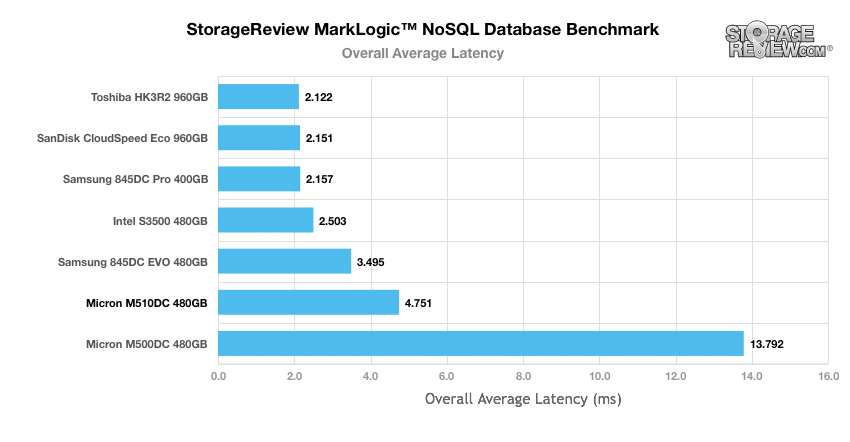
Moving to the average latency portion of our MarkLogic NoSQL tests, the MC510DC posted results that had just a few major spikes, including one that almost reached 90ms.
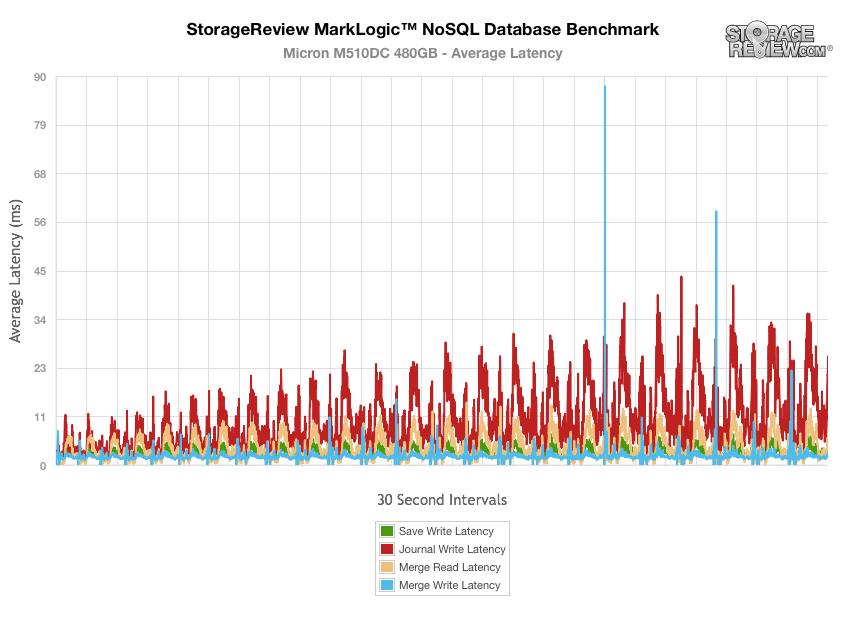
The next application benchmark consists of a Percona MySQL OLTP database measured via SysBench. In this configuration, we use a group of Lenovo ThinkServer RD630s as database clients and the database environment stored on a single drive. This test measures average TPS (Transactions Per Second), average latency, as well as average 99th percentile latency over a range of 2 to 32 threads. Percona and MariaDB are using the Fusion-io flash-aware application APIs in the most recent releases of their databases, although for the purposes of this comparison we test each device in their “legacy” block-storage modes.
In our average transactions per second benchmark, the Micron M510DC measured an initial IOPS of 165.87 and with 1,012.5 IOPS in the terminal. These results placed it last among the list of comparables and behind its M500DC 480GB brethren, which was unsurprising.
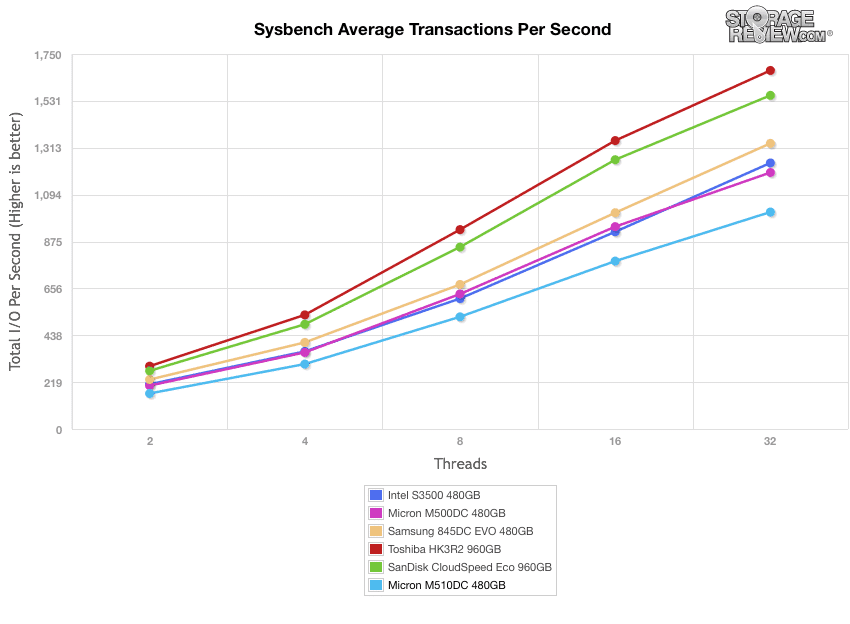
When moving to our Sysbench Average Latency benchmark, the M510DC recorded a range of roughly 12.0ms through 31.60ms by 32T. Toshiba HK3R2 still remains the top performer as it peaked just over 19ms.
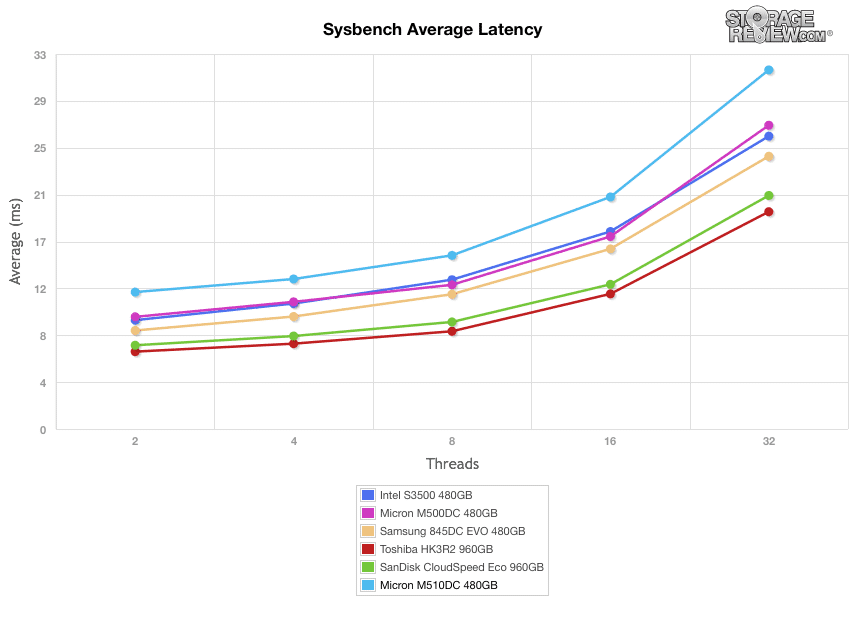
During our worst-case MySQL latency scenario, the M510DC recorded 72.16ms in the terminal, placing last place on the leader board. The top performer in this benchmark was the Samsung 845DC EVO, which posted 48.36ms.
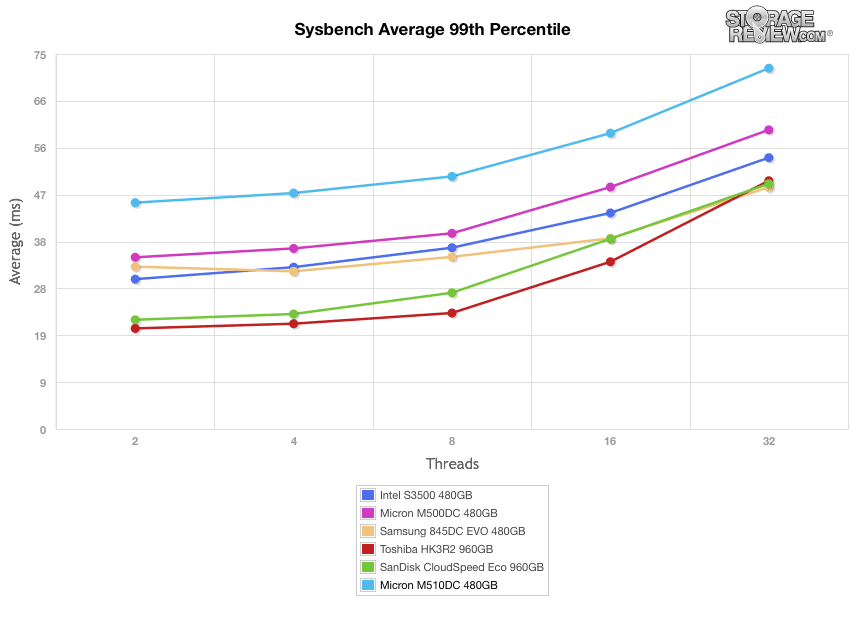
StorageReview’s Microsoft SQL Server OLTP testing protocol employs the current draft of the Transaction Processing Performance Council’s Benchmark C (TPC-C), an online transaction processing benchmark that simulates the activities found in complex application environments. The TPC-C benchmark comes closer than synthetic performance benchmarks to gauging the performance strengths and bottlenecks of storage infrastructure in database environments. Our SQL Server protocol uses a 685GB (3,000 scale) SQL Server database and measures the transactional performance and latency with a 30,000 VU Load.
When looking at SQL Server Output, the M510DC measured 6,230.177TPS (ranking last among the comparables), while its M500DC brother posted 6,283.896TPS (the “FW Fix” indicates a Firmware fix we had to implement during our review of the drive). The top performer here was the Toshiba HK3R2, which measured 6,309.7TPS
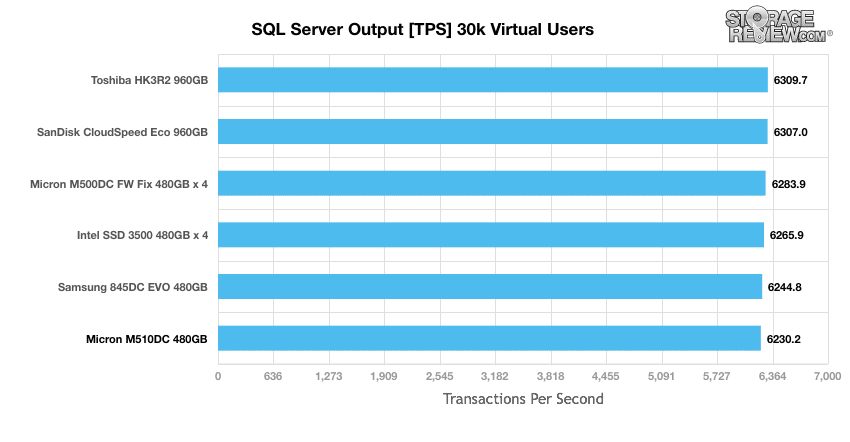
Results of our average latency under a 30k VU from the M510DC showed 67.0ms, which was just behind the Samsung 845DC EVO 480GB. The other Micron drive boasted less than half the latency with 32.0ms.
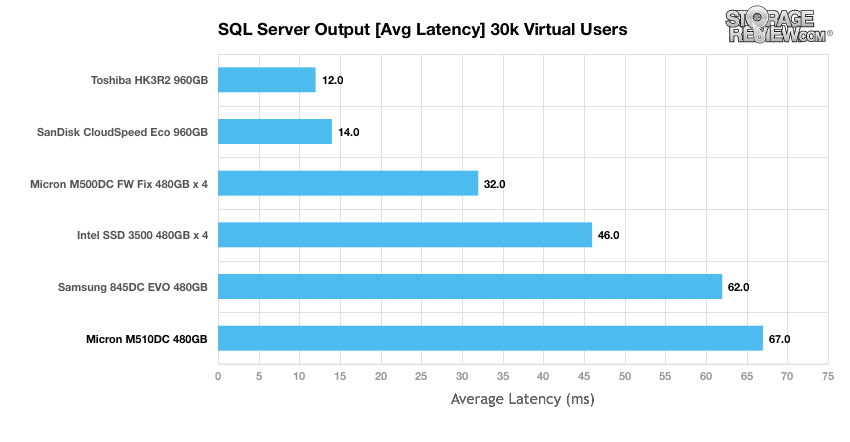
Synthetic Workload Analysis
Our synthetic benchmark protocols each begin by preconditioning the target storage into steady-state with the same workload that will be used to test the device. The preconditioning process uses a heavy load of 16 threads with an outstanding queue of 16 per thread.
- Preconditioning and Primary Steady-State Tests:
- Throughput (Read+Write IOPS Aggregate)
- Average Latency (Read+Write Latency Averaged Together)
- Max Latency (Peak Read or Write Latency)
- Latency Standard Deviation (Read+Write Standard Deviation Averaged Together)
Once preconditioning is complete, each device being compared is then tested across multiple thread/queue depth profiles to show performance under light and heavy usage. Our synthetic workload analysis for the M510DC uses 4k and 8k profiles, which are widely used in manufacturer specifications and benchmarks.
- 4k Profile
- 100% Read and 100% Write
- 8K Profile
- 70% Read, 30% Write
- 100% 8K
In our throughput benchmark, the Micron M510DC drive hovered around 58,000 IOPS during the first portion of the test then the eventually reached 24,164 IOPS by the end of the benchmark for second place.
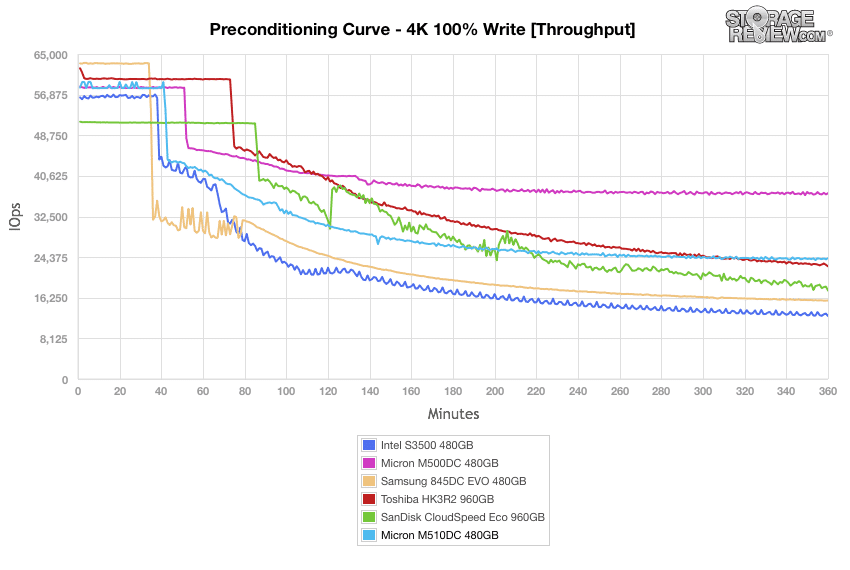
When looking at average latency, the Micron M510DC continued its good performance, as it never surpassed the 11ms mark (10.6ms in the terminal). Its Micron brother, the M500DC, was the top performer here by a significantl margin.
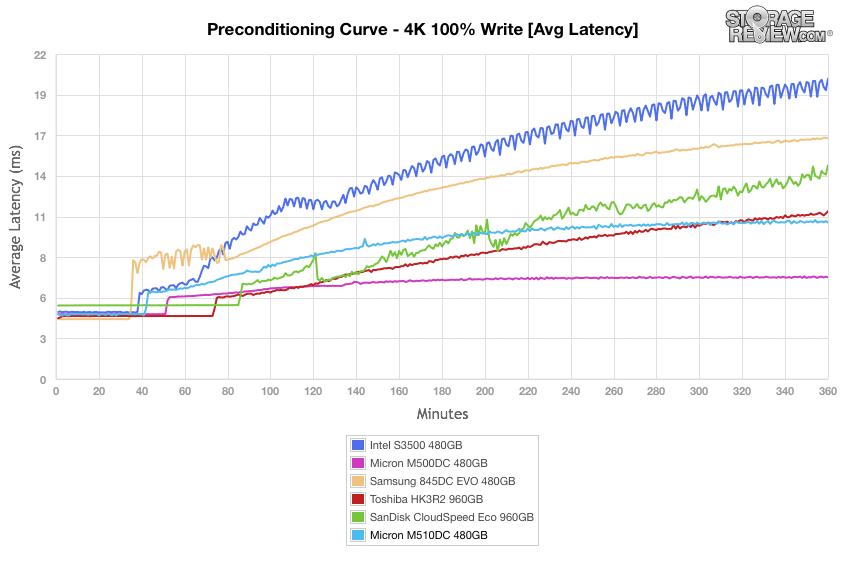
Moving to our max latency benchmark, the M510DC showed latency spikes that only reached the 100ms mark a few times. At the end of the test, it hit 81.031ms placing it in the middle of the pack.
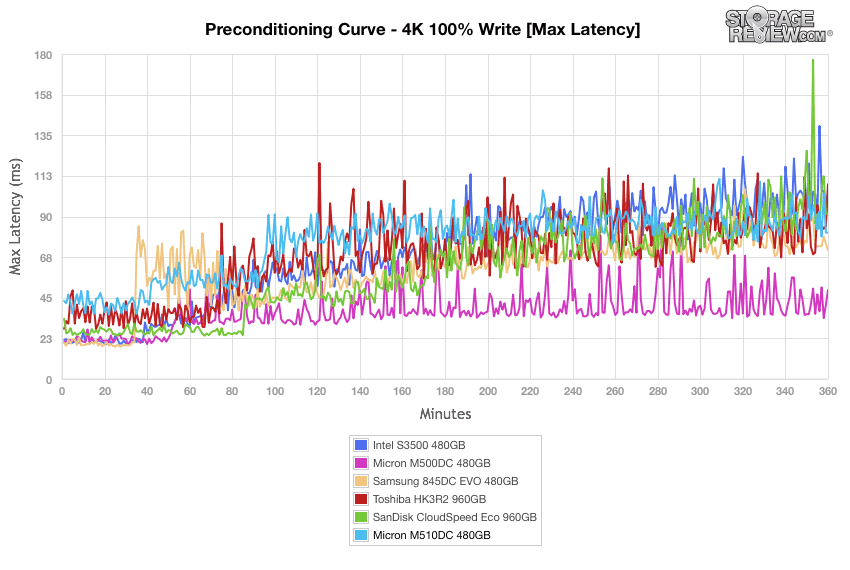
The Micron M510DC posted decent results in our standard deviation test, as it flirted with the 7 to 8ms latency mark at the latter stages of the test. This placed it in the middle of the leaderboard once again, while the M500DC held on to top honors again.
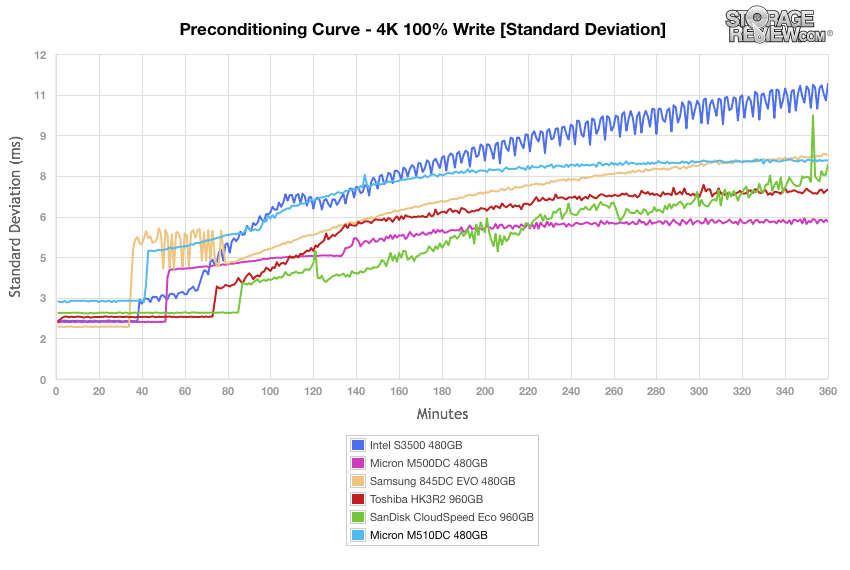
Once the drives have been conditioned, we put them through our primary 4k synthetic benchmarks (16 Thread 16 Queue 100%). Here, the Micron M510DC SSD posted fairly good results. In our throughput test, it measured a decent 23,917 IOPS write and 73,206 IOPS read. Both of these numbers placed it among our leaders.
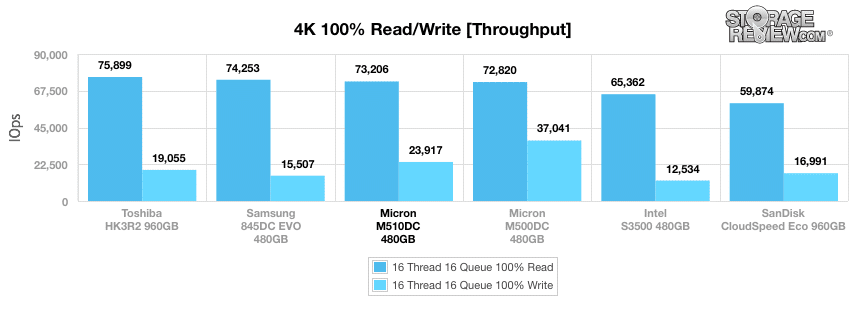
When moving to average latency, the M510DC recorded 10.702ms write and 3.496ms read, placing it near the top of the pack and just in front of its M500DC brother (6.906ms write, 3.513ms read).
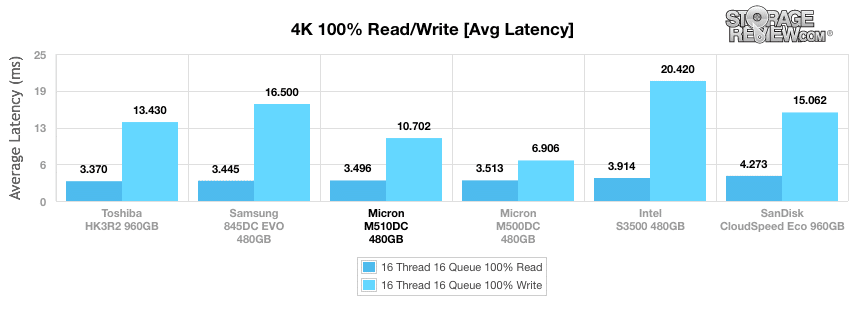
The M510DC took a bit of a hit when looking at max latency, as it had the highest measured peak read speeds with 30.336ms, though it placed better in writes (101.194ms). The top performer here was the Toshiba HK3R2 with 20.13ms read and 101.00ms write.
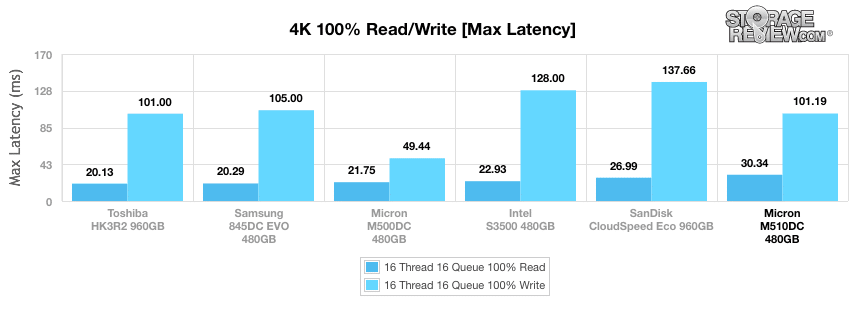
Looking at the M510DC’s standard deviation in 4k latency showed writes and reads of 8.079ms and 2.256ms, respectively. The other Micron light-enterprise drive posted an excellent 5.836ms write and 1.674ms read.
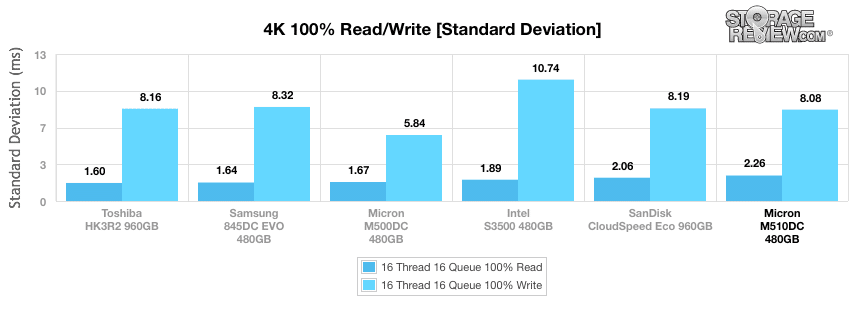
Our next set of preconditioning workloads use 8k transfers with a ratio of 70% read operations and 30% write operations. In the throughput scenario, the M510DC showed good initial speed starting at 41,719 IOPS (better than the M500DC), though it tapered off in the terminal with only 18,466 IOPS.
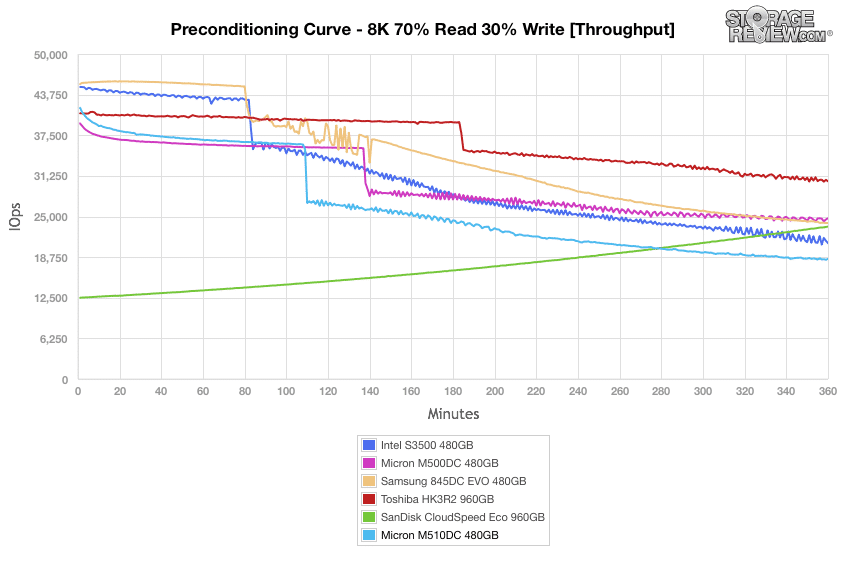
Average latency calculations for the 8k 70/30 preconditioning show the M510DC with decent initial readings again, though it gradually topped out at 13.86ms, which placed it at the bottom of the pack.
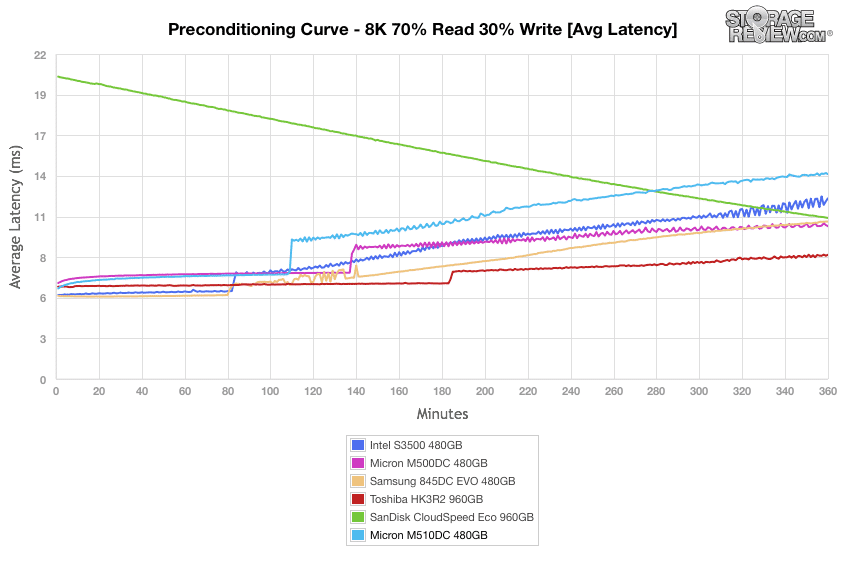
In our max latency benchmark, the M510DC posted an initial peak latency 41.6ms, which gradually rose to almost 73.63ms by the end of the benchmark for a lower-range place among the leaders (and just above the M500DC). The top performer here was the Samsung 845DC 480GB SSD.
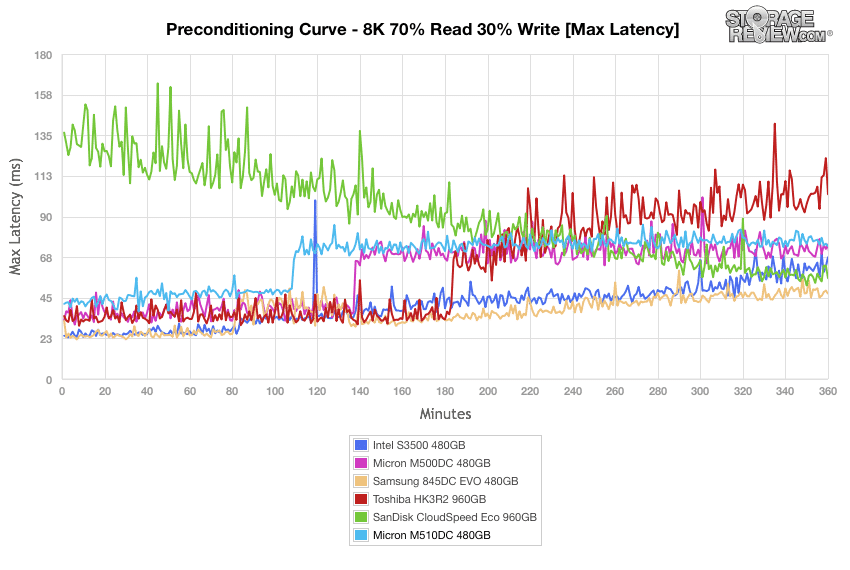
Our last preconditioning test looks at standard deviation. In the first part of the benchmark, the M510DC hovered around the 5ms and ended with roughly 12ms in the terminal queues, which was significantly higher than the rest of the pack.
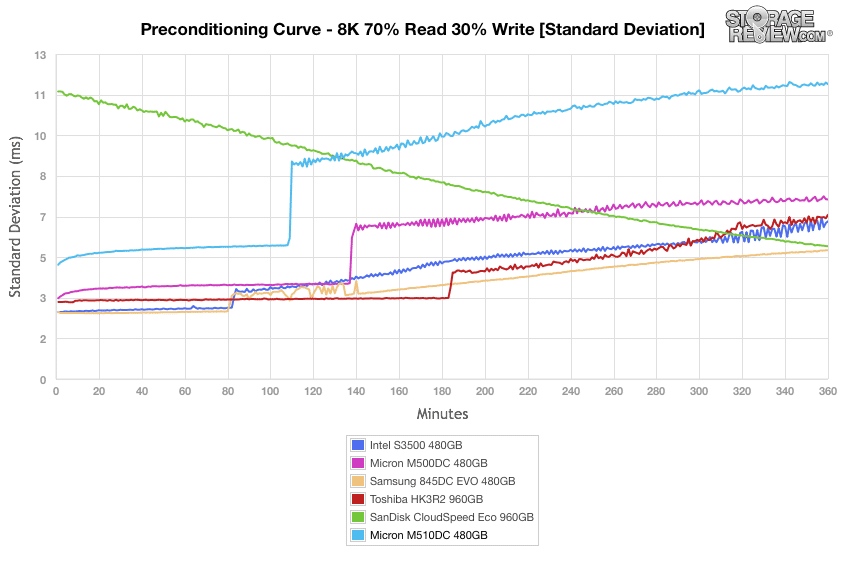
Now that the drives are preconditioned, we put the Micron M510DC SSD through our 8k 70/30 throughput benchmark, which varies workload intensity from 2 threads and 2 queue up to 16 threads and 16 queue. In our throughput benchmark, the M510DC posted a range of 12,572 IOPS to 18,145 IOPS, placing it at the bottom of the leaderboard.
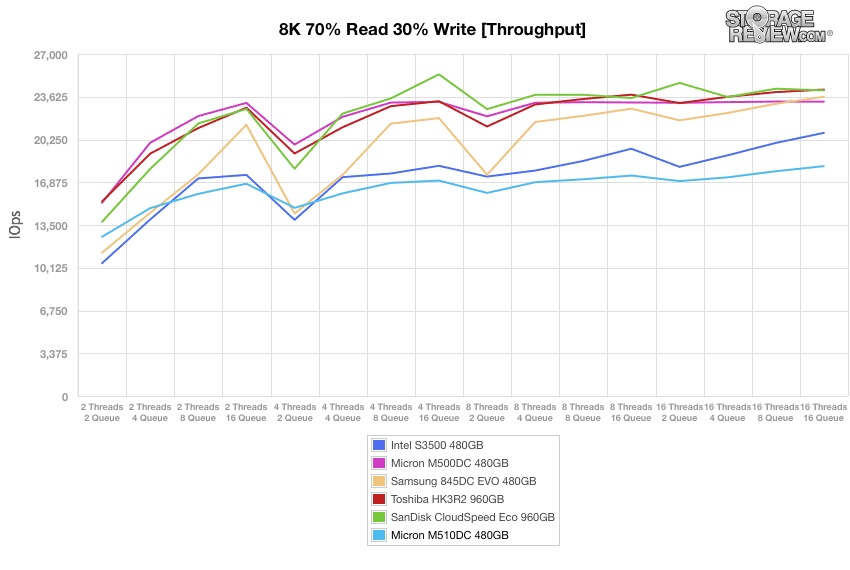
Average latency calculations for the 8k 70/30 preconditioning show the M510DC with a range of 0.31ms to 14.1ms in 16T/16Q.
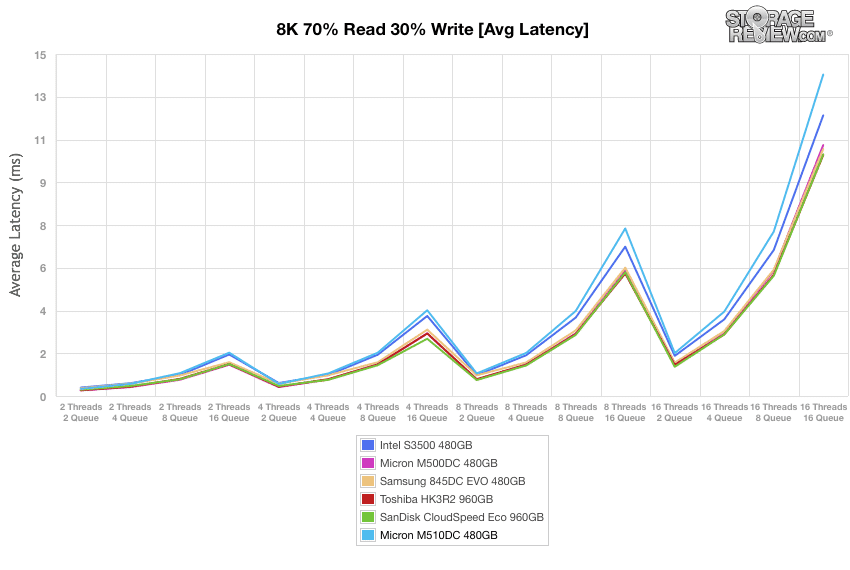
In our max latency test, the new Micron drive posted middle of the pack results with a range of 21.11ms at 2T/2Q and 84.64 at 16T/16Q, which was just above the M500DC. The top performer here was the Samsung 845DC EVO.
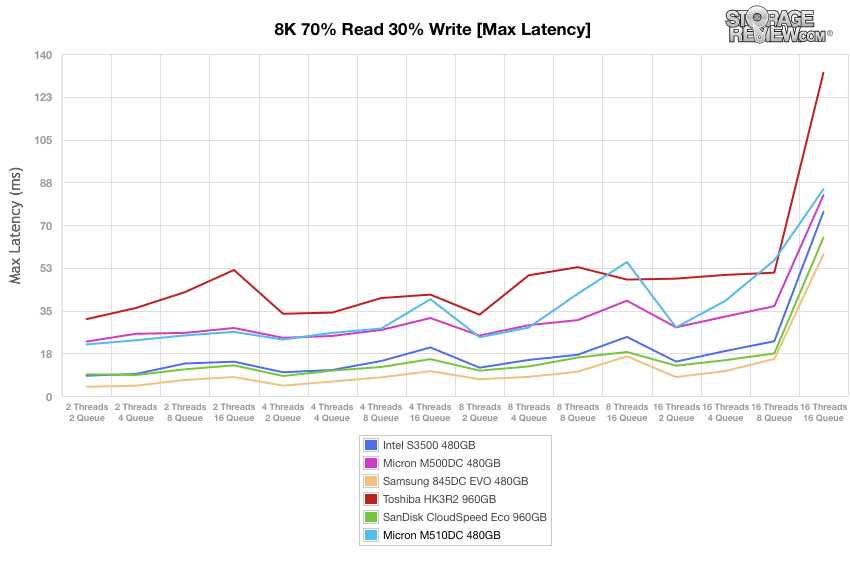
In our last benchmark test of the review, we look at standard deviation once again. Here, the M510DC measured performance that placed it at the bottom of the pack, with 0.75ms at 2T/2Q and 11.89ms in the terminal.
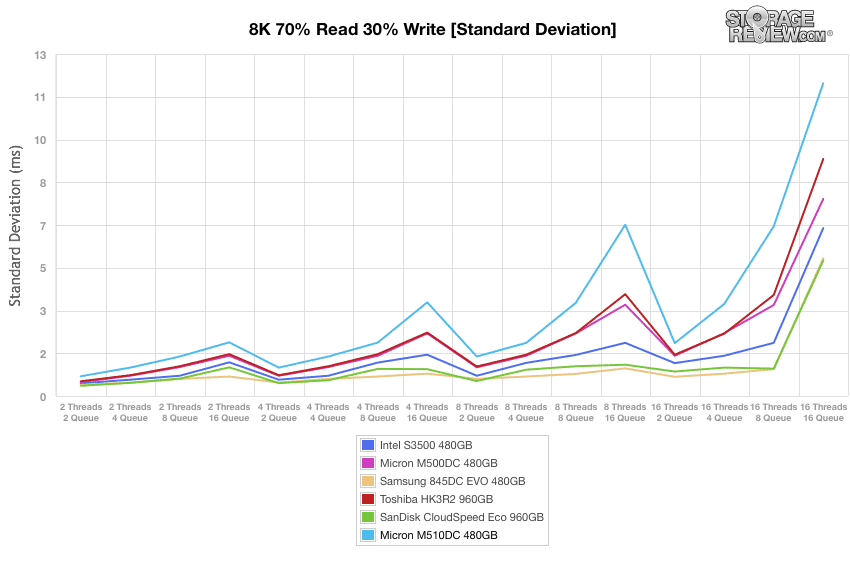
Conclusion
Targeting the entry-enterprise demographic, Micron’s M510DC enterprise SSDs leverage the company’s pedigree in NAND engineering, manufacturing and XPERT technology, the latter which consists of storage architecture enhancements to improve SSD performance and reliability. Micron’s new drive is even more cost effective than the previous M500DC drive, as its main lure is reliability and affordability over performance. The main duties of the M510DC generally consist of scenarios where read-centric, sequential workloads are required. One of the more attractive things about this line of drives is its wide range of enterprise features, including protection again power failures, which are rarely found in the low-cost enterprise SSDs such as these and certainly not in many client SSDs that sometimes find their way into these types of workloads.
When looking at performance, there were no surprises with the M510DC, as it was clear that the main focus of the drive is much more on low-cost, data integrity, and reliable functionality. Micron is well aware of this and makes no illusion that it is a high-performance enterprise drive, as the company did not design it as such. That being said, it did perform fairly well during some of our workloads and even sometimes better than its more expensive brethren, the M500DC. When looking at its application performance, the M510DC showed results in line with its pricing throughout our benchmarks. For example, in the MarkLogic NoSQL Database environment and SysBench tests, the Micron M510DC posted numbers that placed it at the bottom of the leaderboard in every category with the exception of overall average latency, where it placed just above its M500DC brethren.
Things picked up a bit when we switched to our synthetic tests starting with the 4K pre-conditioning benchmarks, which was comprised of 100% read and 100% write workloads. Calculating throughput in this scenario, the new Micron SSD hovered around the 58,000 IOPS mark during the first part of the workload while ultimately reaching 24,164 IOPS by the end of the benchmark for third place. Its latency showed similar results, as it only peaked in the 11ms and 100ms zones for average and maximum readings, respectively. After the pre-conditioning, the M510DC SSD continued its decent results including its throughout performance where it measured 23,917 IOPS write and 73,206 IOPS read, which placed it among the top of leader board. These results were mirrored when looking at its latency.
Micron has released one of the market’s most inexpensive enterprise drives to date, catering to an even lighter workload than the M500DC. Many businesses are looking for the best possible IOPS/dollar and the M510DC is certainly a viable option in this regard. Couple that with the data integrity features and the M510DC will still be compelling, especially when compared to the client SSDs that are notorious for creeping into this space based on price alone, but often without the enterprise-grade data integrity features.
Pros
- Enterprise feature set at a very low cost
- Quality Micron design and build
- Better alternative for entry-enterprise workloads than client SSDs
Cons
- Performance overall isn’t entirely impressive
Bottom Line
With Micron’s in-house components, as well as its enterprise feature-set, the M510DC is a well-built, low-cost line of enterprise drives that are ideal businesses who put importance on data integrity and reliability over blistering performance.




 Amazon
Amazon